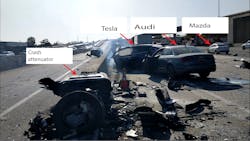NTSB Examines Tesla's Autopilot Limitations Following Fatal Crash
Tesla's Autopilot feature, as well as distracted driving, are the root causes of a March 23, 2018 fatal crash in Mountain View, Calif., according to the National Transportation Safety Board (NTSB).
An investigation into the crash discovered the autonomous vehicle's limitations as well as providing recommendations to improve roadway safety technology. The announcement took place at a public board meeting on Tuesday, Feb. 25, 2020.
NTSB Chairman Robert Sumwalt told the media, “This tragic crash clearly demonstrates the limitations of advanced driver assistance systems available to consumers today. There is not a vehicle currently available to U.S. consumers that is self-driving. Period."
Sumwalt also cautioned consumers about practicing situational awareness on the road, "Every vehicle sold to U.S. consumers still requires the driver to be actively engaged in the driving task, even when advanced driver assistance systems are activated. If you are selling a car with an advanced driver assistance system, you’re not selling a self-driving car. If you are driving a car with an advanced driver assistance system, you don’t own a self-driving car.."
The independent federal agency detailed the events that led to the tragic accident in which a 38-year-old driver of a 2017 Tesla Model X P100D was fatally injured. The driver of the electric-powered sport utility vehicle (SUV) suffered multiple blunt-force trauma after his vehicle, which had the auto manufacturers "Autopilot" feature engaged, left the roadway and struck a damaged and nonoperational crash attenuator at a speed of 70.8 mph.
Two other vehicles then struck the SUV. During the collision, the Tesla's high-voltage battery was damaged, leading to a post-crash fire. According to the NTSB, witnesses removed the Tesla driver from the vehicle before it was engulfed in flames.
NTSB's findings, based on Tesla's "Carlog" data, indicate that Tesla’s forward collision warning system did not signal and the automatic emergency braking did not activate. At no point did the driver use the brakes or steer to avoid the crash.
Investigators also reviewed the driver's cell phone and discovered a game application was active on his Apple iPhone 8. This, the NTSB concluded, showed consistency with a person distracted by a portable electronic device.
The agency provided nine safety recommendations as a result of the investigation, expressing frustration with the National Highway Traffic Safety Administration's (NHTSA) and Tesla's failure to enact prior recommendations going back two years. The NTSB does not act as a regulatory body.
“If you own a car with partial automation, you do not own a self-driving car,” Sumwalt said in his opening statement regarding the investigation. “This means that when driving in the supposed ‘self-driving’ mode, you can’t read a book, you can’t watch a movie or TV show, you can’t text and you can’t play video games.”
The safety issues the NTSB recommended addressing include:
- Expansion of NHTSA’s New Car Assessment Program testing of forward collision avoidance system performance.
- Evaluation of Tesla Autopilot-equipped vehicles to determine if the system’s operating limitations, foreseeability of misuse and ability to operate vehicles outside the intended operational design domain pose an unreasonable risk to safety.
- Collaborative development of standards for driver monitoring systems to minimize driver disengagement, prevent automation complacency and account for foreseeable misuse of the automation.
- Review and revision of distracted driving initiatives to increase employers’ awareness of the need for strong cell phone policies prohibiting portable electronic device use while driving.
- Modification of enforcement strategies for employers who fail to address the hazards of distracted driving.
- Development of a distracted driving lock-out mechanism or application for portable electronic devices that will automatically disable any driver-distracting functions when a vehicle is in motion.
- Development of policy that bans nonemergency use of portable electronic devices while driving by all employees and contractors driving company vehicles, operating company-issued portable electronic devices or when using a portable electronic device to engage in work-related communications.
The National Safety Council (NSC), which has initiated efforts to reduce distracted driving through various initiatives and educational campaigns, released a statement supporting NTSB's recommendations, stating:
The findings in this report underscore the reality that automated vehicles today work with us but not without us.
NSC supports the NTSB recommendation that the National Highway Traffic Safety Administration take a more proactive role in studying, collecting data and requiring automated features on vehicles. NSC also supports recommendations for OSHA to urge employers to institute policies banning employees from using cell phones while driving, as driver distraction appears to have been a causal factor in all crashes referenced in the NTSB report. In the absence of federal regulations, employers can set their own policies, and NSC has been encouraging them to do so for years.
Lastly, NSC commends the call for cell phone manufacturers to implement "Do not disturb" technology that blocks drivers' ability to use cell phones while driving, except in emergency situations.
About the Author

Stefanie Valentic
Stefanie Valentic was formerly managing editor of EHS Today, and is currently editorial director of Waste360.
